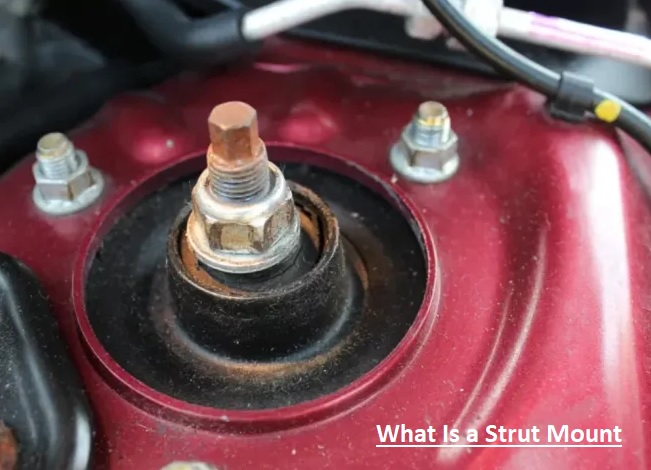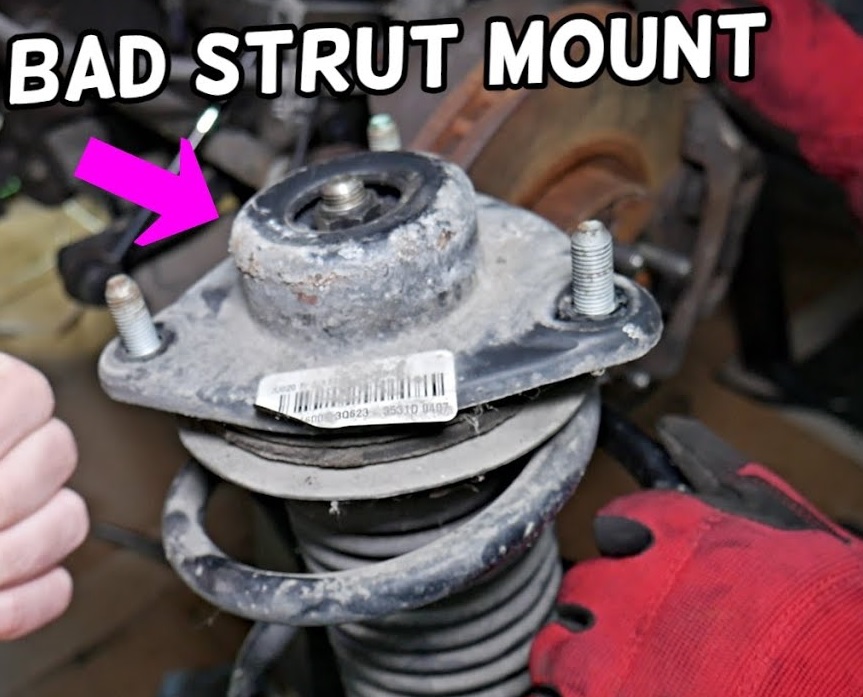If you are facing noise in the car and hearing sounds like clunks and knocks, that needs certain attention for a solution. The car suspension system and steering need certain functions to work in collaboration that to help control the car.
The suspension requires vertical movement, which allows the wheels to turn side by side. For strut suspension systems, it lies on the strut bearing for controlling the required movement. It lies on a strut design that provides a complete strut for movement when we move the steering wheel; as a result, the strut flex shows movement. If struts are not working well or go bad, they affect vehicle movement and need to be repaired, and there is a solution for bad strut mounts.
What Is a Strut Mount?
- The strut mount is the main component used for making the connection of the suspension strut with the chassis of the vehicle.
- It is a connection between the strut and the vehicle that easily absorbs vibrations during traveling.
- Some front strut mounts come with a bearing plate that is used as a steering pivot to provide uniform steering
Working of the strut mounts
The main functions of the strut mounts are as
Connection Point:
- • A strut mount is used for connecting the strut assembly with the car structure, which maintains the suspension system structure.
Damping Vibrations:
- • The strut mount comes with rubber that reduces shocks and vibrations of different road conditions, which helps to make it easy.
Bearing:
- Strut mounts come with bearing plates that control strut rotation. It is important for the front wheel movements of vehicles with that strut component of the steering system.
Alignment:
- Strut mounts also control the alignment of the suspension system, which helps vehicles easily move and control uniform tire wear
Load Bearing:
- struts, mounts, faces, vehicle weight, and forces when driving. So it needed to have a strong design to avoid damage.
Read also What are Different Types of Bolt Heads
Symptoms Of A Bad Strut Mount
Some symptoms help you to find bad strut mounts that are
Different Noises:
- When you drive on uneven roads, facing clunking, knocking noises is a sign of a bad strut mount. If you have a damaged strut mount that produces squeaking sounds on a rough road, it needs special attention.
Steering is not working well
- If the steering wheel does not turn easily a result of resistance in the steering wheel. There can be vehicle drift on the side, a sign of strut mount damage or not holding its position.
Vibrations:
- Your damaged or faulty strut mount causes steering wheel vibrations when turning at high speed.
- Vibration in the cabin is also a sign of a bad strut mount.
Tire Wear:
- Tire wear occurs if the strut mount does not have accurate alignment, which causes wear on tire components.
Damaged strut mount
- Strut mounts can have cracks, corrosion, and other wear that require replacement of the strut mount.
Uncomfortable Riding
- Damaged strut mounts affect our driving, and we face uncomfortable driving since shocks do not absorb on the road accurately.
Where Are The Strut Mounts Located?
- The strut mount makes a connection between the chassis and the strut. It exists in the upper part of the strut, with front struts connected to the steering knuckle and back struts connected to the wheel hub.
- Front strut mounts come with bearings that control the steering pivot. The strut also comes with a rubber that is used as an insulator. rubber control noises and vibrations,
Is it possible to drive with a bad strut mount?
The best thing is not to drive with a damaged strut mount, which can affect driving badly. since bad strut mounts affect vehicle handling and driving conditions. Where are some drawbacks mentioned that occur when driving with a strut mount?
- Due to a bad strut mount, the strut structure becomes loose, the suspension does not bear shocks, and the tire makes continuous contact with the road, which affects suspension working and driving experience.
- If we continue driving with a damaged strut mount, it affects different parts of the suspension, like springs, struts, and other connected parts. so it will increase the repair cost.
- • A faulty strut mount also affects vehicle control and affects the steering and braking system. It can become a cause of an accident in bad driving conditions.
- It can cause tire wear and affect the working life of the tire, as well as vehicle handling and traction.
- Driving with a damaged strut mount reduces the chance of your overall safety. Since for abrupt bumps, the suspension system does not absorb shocks, there is a high chance of accidents.
Inspection process of the Strut Mount
Read alsoBasic Symptoms Of Bad Tie Rod End
There are different methods used for inspecting a bad strut mount, which are
- First, take the driving test and check that a sound exists during steering wheel movement or when moving on bumps; also, face the sound.
- Inspect the surface of the strut mount to find any cracks. If any cracks exist, it means you have a bad strut mount that needs replacement.
- Make sure that the mounting nuts of the strut are tightly connected. If a nut is loose, tighten it.
- Lift the vehicle on jack stands to find any faults.
- Ask a friend to check the struts when moving the steering wheel.
How to Replace A Strut Mount?
Follow these steps for the replacement of the strut mount.
- First of all, park the car on the ground and use the parking brake. After that, use protective accessories like gloves and glasses.
- Lift your vehicle with a jack and provide support through jack stands. Lift the wheel by removing lug nuts.
- Now locate the strut over the wheel structure. Use oil on bolts and nuts for easy disconnection.
- Now disconnect the components connected with the strut and remove the bolts connecting the strut with the steering knuckle. Now locate strut mount bolts through the opening hood at the upper part of the strut tower. Remove the mount bolts through the supporting strut.
- With the help of a spring compressor, compress the coil spring of the strut. Now, remove the holding strut mount after compression.
- Remove the connected strut and connect the new one. but confirm that the alignment of the new strut mount is accurate.
- After that, connect the nut holding on the strut mount, and also remove tension on the spring compressor.
- Connect the strut assembly and put on the strut casing. Connect bolts and nuts.
How Much Does It Cost to Repair a Bad Strut Mount?
There are different factors for replacing strut mounts, like vehicle model, repair service providers, and faults.
-
- Normally, single strut mount charges are 30 to 120 dollars. For replacing the complete strut assembly,the charges are about 200 to 400 dollars.
- Labor charges for strut mounts are about 150 to 350 dollars, depending to the complications of the work.
- But the overall cost for the replacement of a single strut mount is 130 to 450 dollars.
- Replacement: Complete assembly on both parts of the vehicle in the range of 450 to 1300 dollars.
FAQS
How to tell if you have bad strut mounts?
- To check if front strut mounts are faulty, monitor creaking noises when moving over rough roads. also find a crack on the mounting. High looseness during pushing the strut assembly causes wear.
- Worn mounts also affect bad steering and tire wear.
What happens when a top mount fails?
- The damaged strut mount can cause bad alignment of tires. Vibrations affect how tires move on the road. Misalignment causes effects on tire parts, like damage, while others can be unaffected.
Do strut mounts affect ride quality?
- Damaged strut mounts also affect vehicle handling and the safety measures that are needed for the suspension system. Bad strut mounts and bearing plates cause noise; steering binding also causes steering pull.
How long do strut mounts typically last?
-
- Normally, struts work in the range of 50000 to 75000 before replacement with a new module. So there is a need to replace the strut mount bearing after 4 years.

